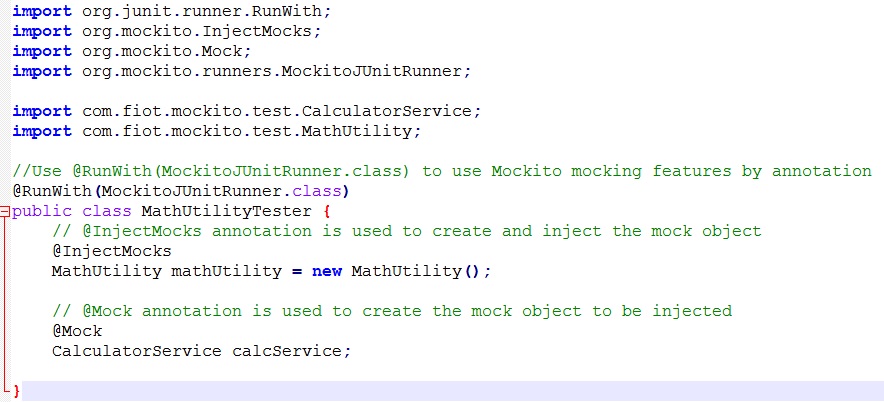Mockito Cannot Mock/Spy Because – Final Class
Introduction:
Mockito is a popular Java testing framework widely used for creating mock objects during unit testing. It allows developers to simulate interactions between objects and write effective test cases. However, Mockito has certain limitations when it comes to mocking or spying on final classes in Java. In this article, we will explore the reasons behind this restriction, discuss alternatives, provide examples of scenarios where mocking or spying is not possible, and conclude with best practices for dealing with final classes in unit tests.
Explanation of Final Classes in Java:
In Java, a final class is a class that cannot be extended. It is intentionally designed to restrict inheritance and prevent any modifications to its implementation. Final classes are often used in scenarios where the class behavior should remain unchanged or where security concerns are involved. These final classes are considered as “sealed” or “closed” classes in the object-oriented programming paradigm.
Limitations of Mockito in Mocking or Spying on Final Classes:
Mockito relies on dynamic proxying and bytecode manipulation to create mock objects. However, it cannot override or modify the behavior of final classes due to their inherent nature. Final classes, by definition, cannot be subclassed or extended, making them impossible to mock or spy upon.
Mockito’s limitation with final classes affects its ability to replace these classes with mock objects during unit tests. This can become a hurdle when final classes are an integral part of the system under test, preventing thorough testing of dependent objects.
Alternatives to Mocking or Spying on Final Classes in Mockito:
To overcome the limitation of Mockito in dealing with final classes, developers can resort to alternative solutions. One such solution is to redesign the codebase by introducing interfaces or abstract classes to replace the final class dependency. This approach allows the usage of Mockito as intended, as interfaces and abstract classes can be easily mocked or spied on.
Additionally, developers can use the PowerMock extension for Mockito, which provides more advanced features for handling final classes. PowerMock uses a combination of bytecode manipulation and reflection to bypass the limitations imposed by final classes. However, it is worth noting that using PowerMock can increase test complexity and may introduce potential maintenance issues.
Examples of Scenarios Where Final Classes Cannot be Mocked or Spied in Mockito:
Let’s consider a scenario where we have a final class called `MathUtils` that contains important calculations. If any other class, say `Calculator`, depends on `MathUtils` for performing calculations, Mockito cannot mock or spy on `MathUtils` to validate the behavior of `Calculator`.
Another instance is if a final class is used as a parameter or return type in a method, Mockito cannot create a mock object for that final class, leading to difficulties in testing methods that rely on it.
Best Practices for Dealing with Final Classes in Unit Tests:
When dealing with final classes in unit tests, it is essential to follow some best practices:
1. Minimize reliance on final classes: Limit the usage of final classes and favor interfaces or abstract classes, as they can be easily mocked or spied on using Mockito.
2. Encapsulate final class dependencies: Wrap final class dependencies within interfaces or abstract classes to facilitate unit testing by introducing loose coupling.
3. Apply alternative testing frameworks: Consider using PowerMock or other testing frameworks specifically designed to handle final classes if their usage is unavoidable.
4. Write integration tests: If unit testing becomes too cumbersome or impossible due to final class dependencies, resort to integration tests to ensure proper system behavior as a whole.
Conclusion:
In conclusion, understanding Mockito’s limitations with final classes is crucial for writing effective unit tests. Final classes, due to their inherent nature, cannot be mocked or spied upon by Mockito. Developers need to find alternatives such as redesigning code to use interfaces or abstract classes or utilizing advanced tools like PowerMock. Taking these considerations into account and following best practices will enable developers to write comprehensive unit tests even in the presence of final classes.
FAQs:
Q1: What is the alternative to Mockito for mocking/spying on final classes in Kotlin?
A1: The popular alternative to Mockito in Kotlin is the “Mockito-Kotlin” library. It provides similar functionality as Mockito but supports mocking and spying on final classes in Kotlin.
Q2: Can Mockito mock or spy on wrapper types like String or Class?
A2: No, Mockito cannot mock or spy on wrapper types like String or Class. It can only mock or spy on objects that are based on non-final classes or interfaces.
Q3: Is it possible to mock or spy on final classes using PHPUnit?
A3: PHPUnit, a unit testing framework for PHP, does not have built-in support for mocking or spying on final classes. Alternative solutions such as using “Mockery” or redesigning the codebase may be required in such cases.
Java :How To Mock A Final Class With Mockito(5Solution)
Can We Mock Final Class With Mockito?
Mockito is a popular open-source testing framework used for unit testing Java applications. It provides a simple and flexible way to create test doubles, also known as mocks, to simulate the behavior of dependencies in our tests. Mockito allows us to easily mock interfaces and classes, but what about final classes?
In Java, a final class is a class that cannot be extended or inherited by any other class. It is often used to ensure that a class cannot be modified or overridden by other developers. Traditionally, final classes have been considered difficult to mock because they are explicitly designed to prevent any kind of modification or extension.
Earlier versions of Mockito did not support mocking final classes, but with the release of Mockito 2, a new feature called “MockMaker” was introduced. MockMaker is an extension mechanism in Mockito that allows the framework to generate mocks for final classes, there are some limitations.
To mock final classes with Mockito, we need to add the “mockito-inline” dependency to our project. This dependency includes the necessary classes and configuration to enable the MockMaker feature. Once we have added the dependency, we can start mocking final classes as we would with any other class or interface.
To create a mock of a final class, we can use the static method “Mockito.mockFinal” provided by the Mockito framework. This method takes the final class as a parameter and returns a mock object that behaves like an instance of the final class. We can then use this mock object to define the desired behavior and verify the interactions in our tests.
It’s important to note that mockito-inline can only mock non-static methods of final classes. Static methods, constructors, and private methods are not mockable. Additionally, final methods from non-final classes can also be mocked. This limitation is due to the nature of final classes and the restrictions imposed by Java itself.
When mocking final classes, we should be aware that the behavior of final methods cannot be changed. Mockito cannot override final methods, so the behavior defined in the final class will be preserved even in the mock object. However, we can still verify the invocations of final methods using Mockito’s verification methods.
Now let’s address some frequently asked questions about mocking final classes with Mockito:
Q: Can we mock final classes in any version of Mockito?
A: No, it is only possible to mock final classes with Mockito 2 and onwards.
Q: Does using mockito-inline affect the performance of our tests?
A: Using mockito-inline does add some overhead to the test execution time. However, the impact is generally negligible unless we are working with a large number of final classes.
Q: Are there any alternatives to mocking final classes with Mockito?
A: Yes, there are other testing frameworks like PowerMock and JMockit that provide support for mocking final classes. However, they may have different syntax and usage, so it’s important to consider and evaluate them based on the specific requirements of your project.
Q: Can we mock final methods of non-final classes with Mockito?
A: Yes, Mockito can mock final methods of non-final classes. This is because final methods can be overridden unlike final classes.
Q: Can we mock final classes in Android projects?
A: Yes, mockito-inline is compatible with Android projects. However, it’s important to ensure that the Mockito version used in the project supports the mockito-inline feature.
In conclusion, mocking final classes with Mockito is now possible thanks to the MockMaker feature introduced in Mockito 2. While there are some limitations to be aware of, it provides a convenient way to mock final classes and verify their interactions in unit tests. By understanding these limitations and applying Mockito’s capabilities effectively, we can enhance the testability of our code even when dealing with final classes.
Why Can T We Mock Final Class?
Mocking objects and creating test doubles are common practices in the field of software testing. They allow developers to isolate specific components of their code and test them independently, ensuring that each piece functions as expected. However, there are certain limitations when it comes to mocking classes, particularly those declared as “final.”
In object-oriented programming, the “final” keyword is used to denote that a class cannot be subclassed or extended. When a class is marked as final, it means that no other class can inherit from it. This concept is an important part of the object-oriented design principles known as “encapsulation” and “composition.”
Encapsulation is the practice of hiding internal implementation details of a class and providing a clean, defined interface for other classes to interact with. By making a class final, developers can ensure that the internal implementation of the class remains intact and cannot be modified or overridden by any subclass.
Composition refers to the practice of building complex systems by combining simpler components. In object-oriented programming, composition is achieved by creating objects of different classes and using them as attributes or members of other classes. When a class is marked as final, it means that it is designed to be a standalone, complete unit that should not be extended or modified by any other class.
Given these principles, it becomes clear why mocking final classes is not allowed. When we create a mock object or test double, we essentially create a subclass of the original class with modified behavior. However, if the original class is marked as final, it explicitly prohibits any subclassing or modification. Therefore, it is not possible to create a mock object for a final class.
One might wonder why a developer would choose to declare a class as final if it hinders the testing process. There are several reasons why a class may be marked as final:
1. Security: Final classes are often used in security-sensitive areas of code, where it is crucial to prevent any unauthorized modifications. By making a class final, developers can ensure that its behavior remains consistent and secure.
2. Performance: Final classes can provide performance benefits by allowing the compiler to make certain optimizations. When a class is marked as final, the compiler can inline method calls and perform other optimizations, resulting in faster execution.
3. Stability: Final classes are typically associated with stable and mature code that has been thoroughly tested. By preventing subclassing, developers can ensure that the class remains stable and does not introduce any unforeseen bugs or issues.
While not being able to mock final classes may present a limitation, there are workarounds that can be employed in testing scenarios. Instead of creating a mock object for a final class, developers can use other techniques such as dependency injection or creating interfaces for classes to allow for easier testing.
FAQs:
Q: Can we modify a final class?
A: No, by design, final classes are not meant to be modified or extended. They are intended to be self-contained and independent.
Q: Are there any other ways to test final classes?
A: Yes, there are alternative techniques like integration testing where the final class is tested as a part of a larger system. Additionally, dependency injection and interface-based programming can provide ways to test components that use final classes.
Q: Can we mock other types of classes in unit tests?
A: Yes, other non-final classes can be mocked and modified for unit tests. In fact, mocking and creating test doubles are widely used practices for isolating and testing specific components.
Q: Why don’t all classes use the final keyword?
A: The decision to mark a class as final depends on the design considerations and requirements of the codebase. Final classes are typically used to provide security, performance, or stability benefits, but not all classes require these attributes.
In conclusion, the inability to mock final classes is a result of the principles of encapsulation and composition in object-oriented programming. While this limitation may present challenges in testing scenarios, it is important to acknowledge the reasons behind using final classes and explore alternative testing techniques. By understanding the purpose and benefits of final classes, developers can make informed decisions about their coding practices and testing strategies.
Keywords searched by users: mockito cannot mock/spy because – final class Kotlin Mockito cannot mock spy because final class, Cannot mock spy because final class, Mockito Cannot mock spy because Cannot mock wrapper types String class or Class class, Mockito Cannot mock this class, PowerMock final class, Mockito-inline, Mock final static variable mockito, Phpunit mock final class
Categories: Top 30 Mockito Cannot Mock/Spy Because – Final Class
See more here: nhanvietluanvan.com
Kotlin Mockito Cannot Mock Spy Because Final Class
Mocking and testing are essential components of modern software development. Mockito is a widely used mocking framework that aids in writing effective unit tests. However, when working with Kotlin, developers often come across an issue where Mockito cannot mock a spy because the class is marked as final. This article will explore the reasons behind this limitation and discuss potential solutions.
Understanding Spies and Mocking
In Mockito, a spy is a partial mock that wraps a real object, allowing us to verify its behavior and stub selected methods. Spying is a powerful technique that facilitates testing by reducing the complexity of mocking behavior completely from scratch. Mockito’s spy functionality combines the benefits of real object invocation and mock verification.
Mocking a class typically involves creating a new instance and modifying its behavior using Mockito’s mocking API. However, Kotlin introduces certain constraints that prevent Mockito from creating spy objects for classes marked as final. This limitation arises due to the differences in the way Kotlin handles inheritance compared to Java.
Final Classes in Kotlin
In Kotlin, by default, classes are marked as final, which means they cannot be subclassed. This design decision is intended to promote better code safety and immutability. While final classes prevent accidental inheritance and ensure the integrity of the codebase, they limit the flexibility of certain mocking frameworks like Mockito.
When implementing inheritance in Kotlin, developers must explicitly declare a class as open to allow it to be subclassed. By default, all classes and functions in Kotlin are final unless marked with the “open” keyword. This practice deviates from Java’s convention where classes are open by default, and developers need to specify the “final” keyword to restrict inheritance.
Effects on Mockito’s Spying
Mockito relies on the ability to create a subclass of the targeted class during the creation of spy objects. Since Kotlin’s default behavior does not allow subclassing, Mockito is unable to create a spy for final classes.
To understand the root cause, we need to examine Mockito’s underlying mechanism for creating spies. Mockito uses Java’s Proxy mechanism to create dynamic proxy classes at runtime that extend the targeted class. These dynamic proxy classes override the desired methods with mock behavior, enabling Mockito to facilitate spying on real objects. However, Kotlin’s restrictions on final classes prevent Mockito from generating the necessary dynamic proxy classes.
Solutions and Workarounds
While Mockito cannot directly mock spy objects for final classes in Kotlin, several workarounds exist to overcome this limitation. Here are a few potential solutions:
1. Avoid marking classes as final: If possible, consider marking the class as open or removing the final modifier. This practice relies on Kotlin’s ability to allow subclassing to enable Mockito to create spy objects successfully.
2. Extract an interface: By extracting an interface from the final class, you can mock the interface instead. This approach allows Mockito to create a mock object that implements the interface, bypassing the limitation on final classes.
3. Utilize additional Kotlin libraries: There are alternative mocking libraries specially designed for Kotlin, such as MockK. These libraries offer better support for Kotlin’s language features, ensuring seamless mocking of final classes.
Frequently Asked Questions
Q: Why does Mockito support mocking final classes in Java, but not in Kotlin?
A: This difference arises due to the default behavior of Kotlin and Java regarding inheritance. Java allows inheritance by default, while Kotlin restricts it unless explicitly declared with the “open” keyword. Mockito’s mechanism relies on subclassing, making it incompatible with Kotlin’s default behavior.
Q: What are the repercussions of removing the final modifier from a class in Kotlin?
A: Removing the final modifier affects the immutability and potential side effects of the code. It allows the class to be subclassed, potentially introducing unforeseen issues if not carefully handled. Evaluating the impact and deciding to remove the final modifier should be done considering the specific context and requirements of the project.
Q: Are there any alternative mocking frameworks for Kotlin?
A: Yes, there are other mocking frameworks like MockK that are built explicitly for Kotlin. These frameworks often provide enhanced support for Kotlin-specific features, making them suitable alternatives when dealing with final classes.
Conclusion
Mocking is an integral part of testing software, and Mockito is a widely adopted framework in the Java ecosystem. However, when working with Kotlin, the default behavior of final classes poses challenges when trying to mock spy objects using Mockito. By understanding the reasons behind this limitation and exploring available workarounds, developers can overcome this issue and continue leveraging the power of Mockito for effective testing in Kotlin projects.
Cannot Mock Spy Because Final Class
## Understanding Final Classes
In object-oriented programming, a final class is a class that cannot be extended or inherited by other classes. This concept is primarily used to prevent further modification or extension of a class, ensuring that its behavior cannot be altered by subclasses. Final classes are often considered as a way to ensure the integrity and security of a class.
## Mocking and Spying in Unit Testing
In unit testing, developers often use mocking and spying techniques to isolate units of code and verify their behavior. Mocking involves creating a fake or mock version of a class or interface, which allows us to control its behavior during testing scenarios. On the other hand, spying allows us to spy on the real objects and verify their interactions with other objects.
## The Limitation: Final Classes Cannot be Mocked
Unfortunately, due to the nature of final classes, they cannot be mocked in unit tests. The reason behind this limitation is that mocking relies on dynamically creating subclasses or proxies of the original class. Since final classes prohibit inheritance, it becomes impossible to create a subclass or proxy for mocking purposes.
Attempting to mock a final class will result in an error or exception, depending on the mocking framework being used. This limitation can be frustrating, as it can hinder the proper testing of units that rely on final classes.
## Alternatives to Mocking Final Classes
While we cannot directly mock final classes, there are alternative approaches we can take to overcome this limitation. Let’s explore a few of them:
### 1. Refactor the Final Class
If possible, consider refactoring the final class to make it non-final. This could involve extracting interfaces or creating non-final subclasses that can be easily mocked. By introducing these changes, you can improve the testability of your codebase.
### 2. Mock Collaborator Objects
If the final class is used as a collaborator within another class, consider mocking other objects that interact with the final class. By doing so, you can indirectly test the behavior of the final class without directly mocking it. This approach leverages the fact that the final class is not the main focus of the test case.
### 3. Use Test Doubles
Test doubles are objects used in unit testing as substitutes for real dependencies. Instead of directly mocking the final class, you can create a test double that mimics its behavior. Test doubles, such as stubs or fakes, can be manually created or generated using mocking frameworks. While not ideal, this approach can help overcome the inability to directly mock final classes.
### 4. Integration Tests
In cases where mocking or bypassing the final class is not feasible, you might need to resort to integration tests instead of unit tests. Integration tests involve testing the interaction between multiple components or systems, including the final class. This allows you to verify the behavior of the final class in a more comprehensive manner.
## FAQs
Here are some frequently asked questions related to the topic:
### Q1: Can final methods be mocked?
A1: No, similar to final classes, final methods cannot be directly mocked because they are not designed to be overridden or modified.
### Q2: Why are final classes used if they cannot be mocked?
A2: Final classes are primarily used to enforce design decisions, prevent unintended modifications, and ensure code integrity. Their inability to be mocked is a trade-off for the added security and stability they provide.
### Q3: Are there any mocking frameworks that can mock final classes?
A3: Some mocking frameworks, such as PowerMock or JMockit, provide extensions that can mock final classes. However, these extensions often rely on bytecode manipulation and may have limitations or compatibility issues depending on the testing environment.
### Q4: Is it good practice to use final classes?
A4: Using final classes is a design decision that depends on the specific requirements of your project. While they can enhance security and maintain code integrity, they can also limit flexibility and testability. Consider the trade-offs before deciding to use final classes.
## Conclusion
In unit testing, the inability to mock final classes poses a challenge, as it limits the fine-grained control over the behavior of the final class in test scenarios. However, by understanding the limitations and exploring alternative approaches such as refactoring, using test doubles, or resorting to integration tests, developers can overcome the challenges posed by final classes. Remember to weigh the advantages and disadvantages of using final classes in your project to make an informed decision. Happy testing!
Images related to the topic mockito cannot mock/spy because – final class

Found 16 images related to mockito cannot mock/spy because – final class theme









Article link: mockito cannot mock/spy because – final class.
Learn more about the topic mockito cannot mock/spy because – final class.
- How to mock a final class with mockito – java – Stack Overflow
- Mock final class and final method with Mockito – David Vlijmincx
- Mock Final Classes and Methods with Mockito | Baeldung
- How to mock a final class with mockito – java – Stack Overflow
- Mockito cannot mock because : final class in Kotlin – MindOrks
- Mock final class and final method with Mockito – David Vlijmincx
- Mocking Private, Static and Void Methods Using Mockito
- Mockito 3 Mock Final Class and Method | wesome.org
- Mockito cannot mock because : final class in Kotlin – MindOrks
- Documentation describes a broken way to mock final classes
- How to mock final classes with Mockito? (Kotlin & Java)
- Mock final classes with Mockito – Igorski
- Mockito 5 Supports Mocking Constructors, Static Methods and …
See more: nhanvietluanvan.com/luat-hoc